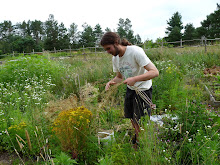
I tilled up a strip 3' by 15' in the rich soil at the very bottom of the orchard, right next to the pond. The little trees are spaced at just over a foot apart. The propagation technique I plan to use for them is to cut them back almost to the ground after they establish themselves for a few years. The trees will then send up new shoots (just like coppicing a forest) which I'll mound soil around. Under the soil the new shoots will produce roots off their stems, then in the dormant season the shoots (now rooted) can be exposed and cut right back to the tree's stool. The process can be repeated for years while the trees will forever remain fairly small, hence the tight spacing.
By the way, this is the reflective pond view the new trees will have:







